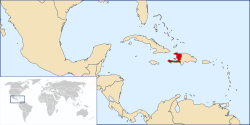First Empire of Haiti
| Empire of Haiti | ||||||||||||
| Empire d'Haïti Anpi an Ayiti | ||||||||||||
| ||||||||||||
| Motto Liberté ou la Mort! (French) "Liberty or Death!" | ||||||||||||
 The Empire of Haiti | ||||||||||||
| Capital | Port-au-Prince | |||||||||||
| Languages | French Haitian Creole | |||||||||||
| Religion | Roman Catholic | |||||||||||
| Government | Elective monarchy | |||||||||||
| Emperor | ||||||||||||
| • | 1804–1806 | Jacques I | ||||||||||
| History | ||||||||||||
| • | Haitian Independence | 1 January 1804 | ||||||||||
| • | Established | 22 September 1804 | ||||||||||
| • | Disestablished | 17 October 1806 | ||||||||||
| Currency | Haitian livre | |||||||||||
| ||||||||||||
The First Empire of Haiti (French: Empire d'Haïti; Haitian Creole: Anpi an Ayiti) was an elective monarchy in North America. Haiti was controlled by France before declaring independence on January 1, 1804. The Governor-General of Haiti, Jean-Jacques Dessalines, created the empire on September 22, 1804. Proclaiming himself Emperor Jacques I, he held his coronation ceremony on October 6. The constitution of May 20, 1805 set out the way the empire was to be governed, with the country split into six military divisions. The general of each division corresponded directly with the emperor, or the general in chief appointed by the emperor. The constitution also set out the succession to the throne, with the crown being elective and the reigning emperor having the power to appoint his successor. The constitution also banned white people[1] from owning property inside the empire.
Emperor Jacques I was assassinated on October 17, 1806. Two members of his administration, Alexandre Pétion and Henri Christophe, then assumed power, which led to a split in the country with Pétion leading the southern Republic of Haiti and Christophe leading the northern State of Haiti. Some 43 years later, on August 26, 1849, President Faustin Soulouque re-established an Empire in Haiti that lasted until January 15, 1859.
[2]
- ↑ "Haiti: 1805 Constitution".
- ↑ "Haiti: 1805 Constitution". faculty.webster.edu. Retrieved 2016-09-11.
.svg.png)